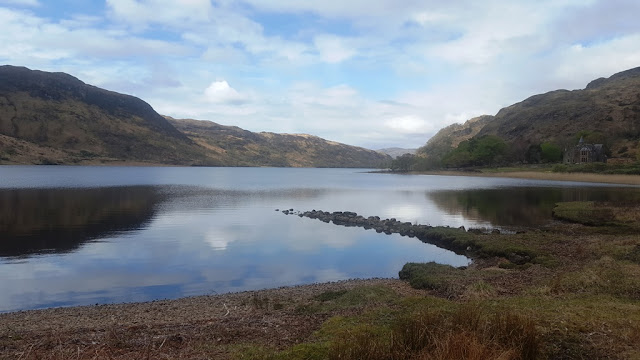On the very edge of the Central Complex
Had about half an hour at lunchtime when in Salen so I decided to have a stroll up part of Cruach Torr an Lochan, the prominent hill between Salen and Gruline. There is a path that leads up the hill, muddy in places but straightforward. Only had time to go a short distance.
At this point we are right on the edge of the Mull Central Complex. If you look at the geology map you will see a really complicated bit in the middle and lots of simpler geology to the north. The complicated bit is the Mull Central Complex - the stuff to the north is mainly basalt lavas and minor intrusions. By walking up this path, you are actually right on the boundary between the two, near enough.
Also in this area are two quarries that are mentioned in the GA Guide that was published in the late 60s. The GA Guide refers to them as part of the Knock / Loch Ba excursion. I decided to have a look
First quarry:
At this point we are right on the edge of the Mull Central Complex. If you look at the geology map you will see a really complicated bit in the middle and lots of simpler geology to the north. The complicated bit is the Mull Central Complex - the stuff to the north is mainly basalt lavas and minor intrusions. By walking up this path, you are actually right on the boundary between the two, near enough.
Also in this area are two quarries that are mentioned in the GA Guide that was published in the late 60s. The GA Guide refers to them as part of the Knock / Loch Ba excursion. I decided to have a look
First quarry:
Quarry is in basalt lavas and gets used for storage these days. The quarry face has a lot of calcite veining running through it. Many of the veins are over 3 cm thick, full of massive calcite, running vertcal to sub-vertical through the face.
The calcite is the white mineral and it has broken off in large pieces.
On the way to the second quarry we pass this sign:
The path continues in a loop and comes out on the main Salen - Craignure road. On the way you pass a great example of a composite dyke. It is in a small quarry. I didnt visit it today but here is a pic from last year:
This one is a beauty. The interior part (the cream coloured bit) is a felsite of some sort - very altered. The edges are mafic, very fine grained basaltic looking material.The dyke can be seen on the other side of the quarry as well.. It trends NW-SE - a fairly typical orientation! Its worth a look - easy to get to as it is only a short distance from the main road.
The second quarry was dug into what is called the Toll Doire Granophyre. Toll Doire is the placename where the quarry is found.. The rock is cream coloured like many of these granophyres and quite different from the basalt lavas which are grey to black. The quarry is now seriously overgrown but the rock can be seen on the path beside it
The granophyre quarry, overgrown
Granophyre in situ, on the path that leads up the hill through the trees. Not the most exciting picture! This particular granophyre has been studied for some research papers. Walsh et al in a 1979 paper "Geochemistry and Petrogenesis of Tertiary Granitic Rocks from the Island of Mull, Northwest Scotland" looked at it along with others.Easy to get good samples as there are still a few quarried blocks lying around.
Up on the hill above the trees the views are great. Cruach Torr an Lochain looms up ahaead and the views in all directions are nice. Esp on today when a rainbow put in an appearance
Cruach Torr an Lochain with the sun to the right
Cruach Torr an Lochain , going by the BGS map, is mainly composed of a mass of cone sheets cutting lavas.
On the way down I noticed an outcrop of rock on the path that is quite different from the rest. I have seen this before - it looks like a psammite (quartzite) but the field relations are hard to make out. It is just above the granophyre and below the basalt. Is this Moine psammite? It might of course just be a large block that is not in situ.
Psammite on the path: It looks very simialr to the psammites you see at Gribun or near Scoor. The BGS map indicates an outcrop of Jurassic age rocks at Glac a Chlaonnain which is a short distance away, but there is no indication of any older metamorphics. - there is nothing on the map to indicate what this stuff actually is. An odd one.
So that was today's short stroll. If anyone has any ideas on that psammite, let me know!














Comments